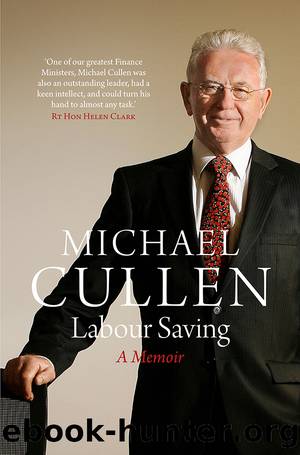Labour Saving by Cullen Michael

Author:Cullen, Michael
Language: eng
Format: epub
Publisher: Allen & Unwin
Published: 2021-04-14T00:00:00+00:00
The year business went to the barricades
The new year began with an unwelcome present from Reserve Bank governor Don Brash â a twenty-five point rise in the overnight cash rate (to 5.25 per cent). The economy had been growing strongly through much of 1999, but had been coming off a very low base. Brashâs announcement was made just two hours before the Statistics Department was due to release its latest figures for the Consumer Price Index. The RBNZ had forecast a quarterly inflation figure of 0.8 per cent (just above the top end of the target range on an annualised basis). In fact the quarterly figure was only 0.2 per cent, and the annual figure was only 1.3 per cent. It seemed to me silly that the order of the two events was such that the RBNZ was looking like it was overreacting (which it was). Subsequently, I have become convinced that what the bank was really targeting was not inflation per se, but what is called the output gap, the estimated difference between current output in the economy and its sustainable level of growth (in an economic, not an environmental, sense). A good deal of research since 2000 has also shown that the least well-off are usually the last to benefit from an upswing in an economy. The consequence of this is that if monetary policy was consistently overactive in that regard, and growth cycles were choked off too early, then the result was a widening of income and wealth gaps over time.
This was not the only problem thrown at us in the first week or so back at work in 2000. The Statistics Department had been undertaking one of its regular redesigns of the Quarterly Employment Survey. This had become the major source of accepted information on employment matters, including wage movements. In this instance the redesign led to a not-insignificant lowering of the estimate of the net average ordinary-time weekly wage. If the latest figures were used as the basis for the standard calculation of the new rates of NZ Super, then the outcome would have been a lower increase than pensioners had been expecting from us. We decided instead, in the light of the promise on our pledge card, to use the old calculation of the average net wage as the basis for the upcoming adjustment to NZ Super rates. This meant that the married couple rate would stand at 67 per cent of the newly calculated average wage, a large increase compared with what it would have been under National.
Despite this, and many other good things the LabourâAlliance government did in the first half of 2000, that period, and some time thereafter, was dominated by what came to be seen as something approaching a stand-off between the government and business interests. Tax was part of it, even though many small-business owners would be unaffected by the new top rate. But the main points of dispute were the changes to accident compensation and employment relations law. The government was not looking for a fight.
Download
This site does not store any files on its server. We only index and link to content provided by other sites. Please contact the content providers to delete copyright contents if any and email us, we'll remove relevant links or contents immediately.
| Anthropology | Archaeology |
| Philosophy | Politics & Government |
| Social Sciences | Sociology |
| Women's Studies |
Cecilia; Or, Memoirs of an Heiress — Volume 1 by Fanny Burney(31374)
Cecilia; Or, Memoirs of an Heiress — Volume 3 by Fanny Burney(30969)
Cecilia; Or, Memoirs of an Heiress — Volume 2 by Fanny Burney(30922)
The Great Music City by Andrea Baker(22332)
We're Going to Need More Wine by Gabrielle Union(18108)
Bombshells: Glamour Girls of a Lifetime by Sullivan Steve(13141)
Pimp by Iceberg Slim(12972)
All the Missing Girls by Megan Miranda(12811)
Fifty Shades Freed by E L James(12478)
Talking to Strangers by Malcolm Gladwell(11950)
Norse Mythology by Gaiman Neil(11938)
Crazy Rich Asians by Kevin Kwan(8393)
Mindhunter: Inside the FBI's Elite Serial Crime Unit by John E. Douglas & Mark Olshaker(7873)
The Lost Art of Listening by Michael P. Nichols(6509)
Enlightenment Now: The Case for Reason, Science, Humanism, and Progress by Steven Pinker(6433)
Bad Blood by John Carreyrou(5799)
The Four Agreements by Don Miguel Ruiz(5551)
Weapons of Math Destruction by Cathy O'Neil(5075)
We Need to Talk by Celeste Headlee(4902)
